Nature has a fascinating way of repeating patterns, creating doppelgängers that trick our eyes and challenge our bird-watching skills. Hummingbirds, with their jeweled feathers, iridescent hues, and rapid wingbeats, are among the most enchanting avians gracing our gardens and forests.
But they aren’t alone in their captivating appearance. There are a number of birds that, upon first glance, you might swear are hummingbirds — but look again. In this blog post, we’ll delve into the world of birds that bear a remarkable resemblance to our beloved hummers, exploring their unique characteristics and dispelling any ornithological double-takes.
So, keep your binoculars close and prepare for a fluttering journey of avian discovery.
Ruby Throated Hummingbird
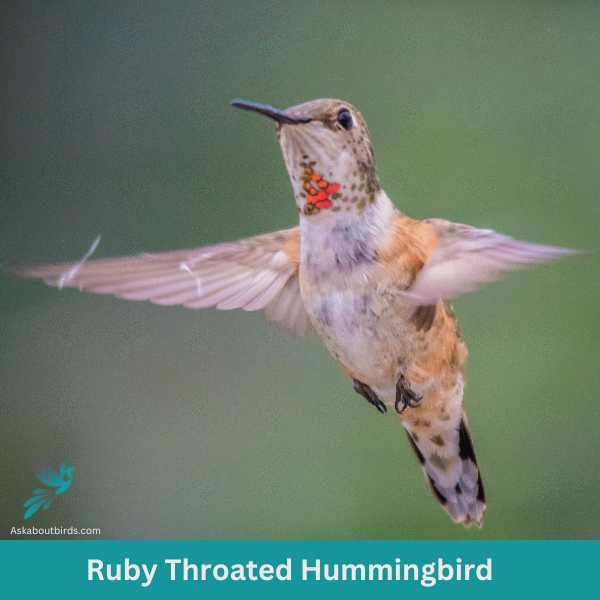

| Feature | Measurement |
|---|---|
| Scientific Name | Archilochus colubris |
| Length | 3-3.5 inches |
| Wingspan | 4-4.5 inches |
| Weight | 0.1-0.2 ounces |
The Ruby-throated Hummingbird is a small, vibrantly colored bird, renowned for being the only species of hummingbird that breeds in eastern North America.
Appearance: The male Ruby-throated Hummingbird is most recognizable by its brilliant red throat or “gorget.” The rest of its upper body is primarily green, while the underparts are a whitish hue. Females lack the radiant red throat, instead featuring a pale, often white, throat and chest. Both genders possess iridescent green feathers on their backs and crowns.
Diet: Ruby-throated Hummingbirds primarily feed on the nectar from red or orange tubular flowers. Their long, specially adapted bills and extendable, tube-like tongues allow them to access the nectar deep within blooms. They consume insects and spiders for protein, catching them mid-air or picking them off plants.
Reproduction: These hummingbirds typically nest in trees or shrubs. The female is responsible for building the nest, which is a compact cup made of plant down and spider silk, camouflaged with lichen. She lays a clutch of 2 tiny, white eggs, which she incubates for about two weeks.
Birds That Look Like Hummingbirds
Eastern Spinebill
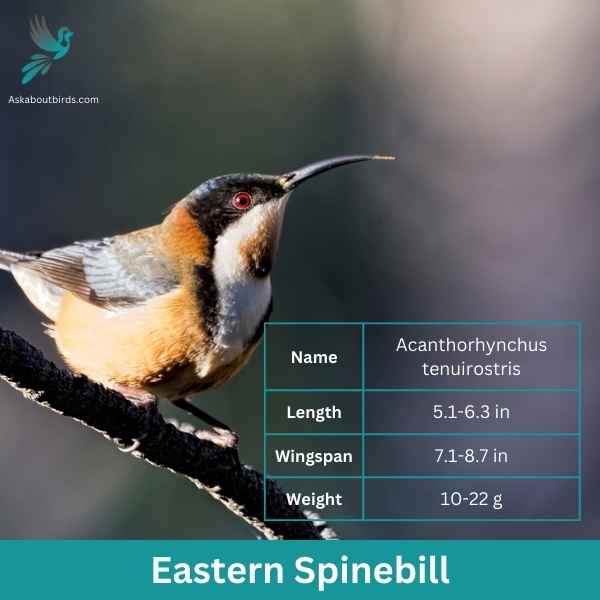

| Feature | Measurement |
|---|---|
| Scientific Name | Acanthorhynchus tenuirostris |
| Length | 5.1-6.3 in |
| Wingspan | 7.1-8.7 in |
| Weight | 10-22 g |
The Eastern Spinebill is a distinctive bird commonly found in the forests and woodlands of southeastern Australia, known for its energetic behavior and nectar-feeding habits.
Appearance: The Eastern Spinebill sports a curved bill, which it uses to access nectar from flowers. Its upper body is mostly grey with white underparts, contrasted with a chestnut patch behind the eye and a rufous band across the chest. Males and females are somewhat similar, although males have more vibrant coloration.
Diet: Primarily, the Eastern Spinebill feeds on nectar from a variety of flowering plants. However, they also consume insects and spiders, especially when feeding their young or during times when nectar is scarce. Reproduction: Eastern Spinebills build cup-shaped nests, often situated in dense shrubs. The female usually lays 2 to 3 eggs, which are incubated for about two weeks.
Similarities
- They feed on nectar, much like hummingbirds.
- Both possess a rapid, agile flight.
Differences
- Eastern Spinebills are generally larger than many hummingbirds.
- They have a notably long and down-curved bill.
Brown Honeyeater
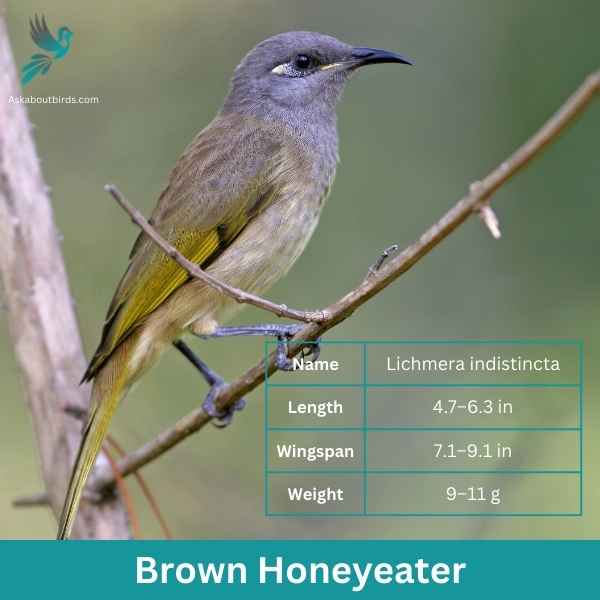

| Feature | Measurement |
|---|---|
| Scientific Name | Lichmera indistincta |
| Length | 4.7–6.3 in |
| Wingspan | 7.1–9.1 in |
| Weight | 9–11 g |
The Brown Honeyeater is a prevalent bird found across Australia, particularly in its northern and western regions. It is known for its melodious song and its affinity for nectar-rich flowers.
Appearance: The Brown Honeyeater, as its name suggests, is predominantly brown in color. It has a pale eye ring, a yellow patch on the base of the flight feathers, and a slender, curved bill apt for nectar-feeding. Both sexes appear similar, although the male might exhibit a brighter yellow patch.
Diet: Nectar is the primary diet of the Brown Honeyeater, which it gathers from various flowering plants. In addition to nectar, these birds will eat insects and spiders, capturing them mid-air or plucking them from foliage.
Reproduction: Brown Honeyeaters often construct their nests in shrubs or trees, crafting a small, cup-shaped structure. Typically, the female lays 2 to 3 eggs, which are then incubated for a couple of weeks.
Similarities
- Both species are nectar feeders.
- Both possess agile flight capabilities.
Differences
- Brown Honeyeaters have a different vocalization pattern compared to hummingbirds.
- Their size and body structure differ, with honeyeaters being generally more streamlined.
White-cheeked Honeyeater
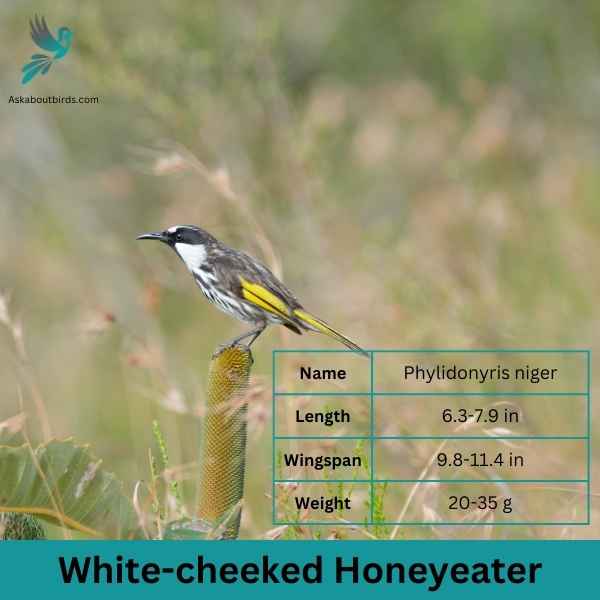
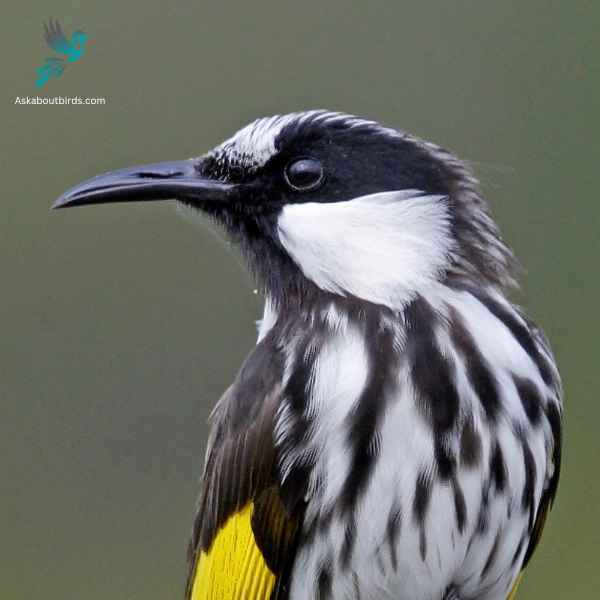
| Feature | Measurement |
|---|---|
| Scientific Name | Phylidonyris niger |
| Length | 6.3-7.9 in |
| Wingspan | 9.8-11.4 in |
| Weight | 20-35 g |
The White-cheeked Honeyeater is a striking bird commonly found along the eastern coastline of Australia, recognized for its vivacious call and active foraging behavior.
Appearance: The White-cheeked Honeyeater sports a predominantly black body and head, contrasted with bright white patches on the cheeks. Its eye is encircled by a yellow ring, and it possesses a slender, nectar-adapted bill. Both male and female White-cheeked Honeyeaters exhibit these same striking features.
Diet: The primary source of sustenance for the White-cheeked Honeyeater is nectar from a diverse array of flowering plants. However, to supplement their diet and especially during breeding seasons, they also consume insects and occasionally fruits.
Reproduction: White-cheeked Honeyeaters build their nests in dense shrubbery or low trees. The nest is cup-shaped, often woven with grass and spiderwebs. Typically, the female lays 2 to 3 eggs.
Similarities
- Like hummingbirds, they feed on nectar.
- They can hover, although less frequently than hummingbirds.
Differences
- White-cheeked Honeyeaters are generally larger than most hummingbirds.
- They have distinctive white cheeks, which hummingbirds do not possess.
Oriental Dwarf Kingfisher

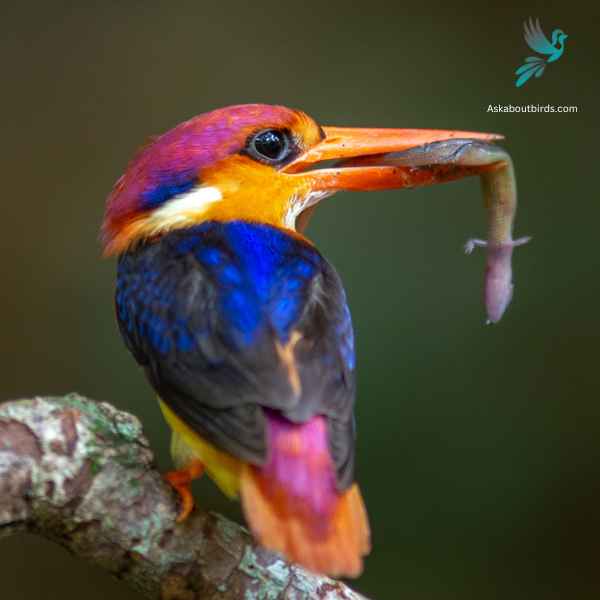
| Feature | Measurement |
|---|---|
| Scientific Name | Ceyx erithaca |
| Length | 5.1 inches |
| Wingspan | 6.7 inches |
| Weight | 0.4-0.5 ounces |
The Oriental Dwarf Kingfisher is a brightly colored, diminutive bird that can be found across parts of South Asia.
Appearance: This kingfisher showcases a vibrant palette of colors with a mix of orange, yellow, pink, blue, and violet. The upper parts of the body and wings display purples and blues, while the underparts are generally rufous-orange. Their small size and vivid coloration make them easily distinguishable from other kingfishers.
Diet: They predominantly feed on insects such as crickets, dragonflies, and beetles. Occasionally, they may also consume small amphibians, fish, and crabs, catching their prey with swift and accurate dives.
Reproduction: The Oriental Dwarf Kingfisher burrows nests into the soft riverbanks or earthy embankments. The tunnel typically ends in a chamber where the female lays 4 to 5 eggs. Both parents participate in incubating the eggs and feeding the chicks once they hatch. The nesting season usually corresponds with the onset of monsoon rains in their respective habitats.
Olive-backed sunbird
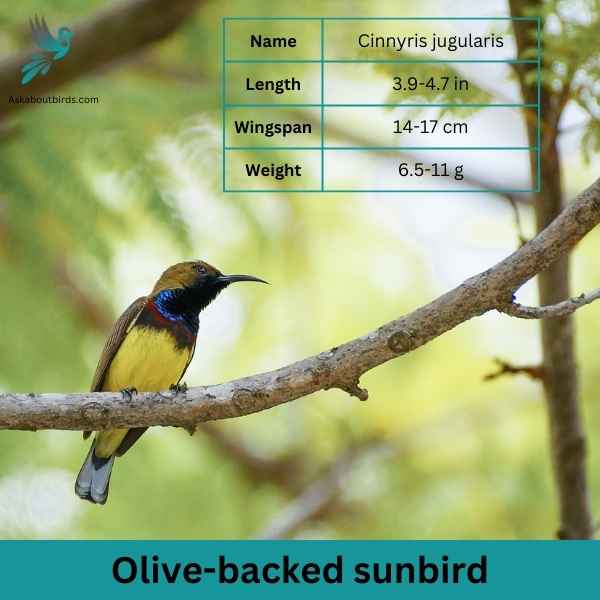
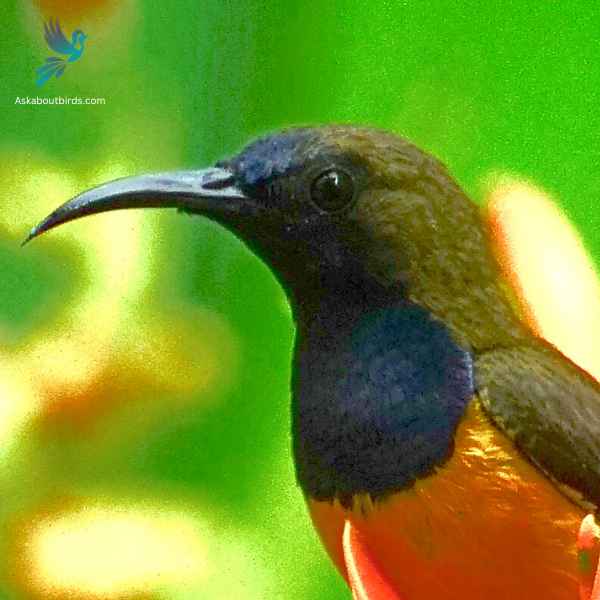
| Feature | Measurement |
|---|---|
| Scientific Name | Cinnyris jugularis |
| Length | 3.9-4.7 in |
| Wingspan | 14-17 cm |
| Weight | 6.5-11 g |
The Olive-backed Sunbird is a petite and vivacious bird predominantly found in Southeast Asia and parts of Australia, renowned for its iridescent plumage and dynamic behavior.
Appearance: Males of this species are particularly vibrant, with a metallic blue throat and chest, contrasting against their olive-green back. Females are more subdued in hue, being mostly olive-brown throughout with a lighter belly. Both genders have a long, downward-curving beak, which is adapted for nectar-feeding.
Diet: Olive-backed Sunbirds mainly sustain themselves on nectar, using their specialized beaks to extract it from flowers. However, they also feed on small insects and spiders, especially during breeding season or when nectar is scarce.
Reproduction: These sunbirds are known for their intricate hanging nests, which they often attach to tree branches or even human structures. The nest, resembling a pouch, is made of plant materials and spider webs.
Similarities
- Both species primarily feed on nectar.
- Iridescent plumage is present in both.
Differences
- Sunbirds have a down-curved beak, while hummingbirds usually have a straight or slightly curved beak.
- The sunbirds are generally larger.
Tufted Flycatcher
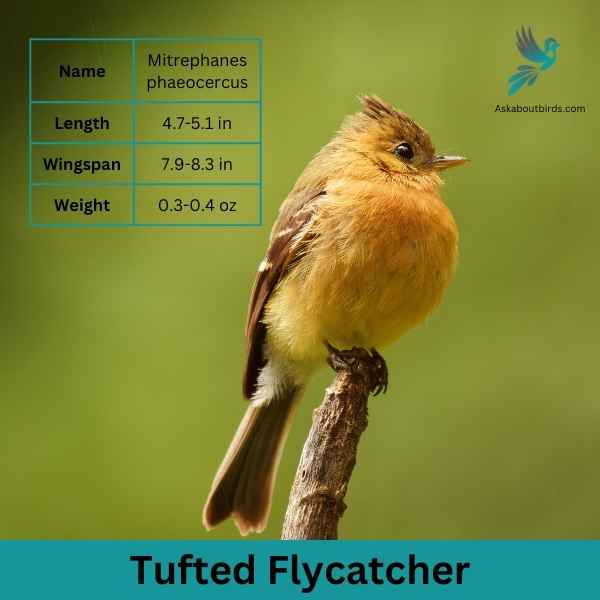

| Feature | Measurement |
|---|---|
| Scientific Name | Mitrephanes phaeocercus |
| Length | 4.7-5.1 in |
| Wingspan | 7.9-8.3 in |
| Weight | 0.3-0.4 oz |
The Tufted Flycatcher is a small bird known for its agile flight and distinctive tuft, predominantly found in the mountainous regions of Central and South America.
Appearance: This bird has olive-green upperparts with a slight bronze sheen on the crown. Its underparts are pale yellow. The most distinctive feature is the tuft or crest on its head, which gives the bird its name. Bright lemon-yellow underparts contrast with its darker wings and tail.
Diet: As the name suggests, the Tufted Flycatcher primarily feeds on flying insects, which it catches in mid-air using its agile flight maneuvers. It perches and waits, often bobbing its tail, before darting out to snatch its prey.
Reproduction: Tufted Flycatchers build cup-shaped nests on branches, often near streams. The female typically lays 2 eggs, which she incubates for about two weeks.
Hummingbird Moths That look like hummingbirds
Like hummingbirds, a hummingbird moth feasts on nectar and have rapid wing flaps.
Rocky Mountain Clearwing
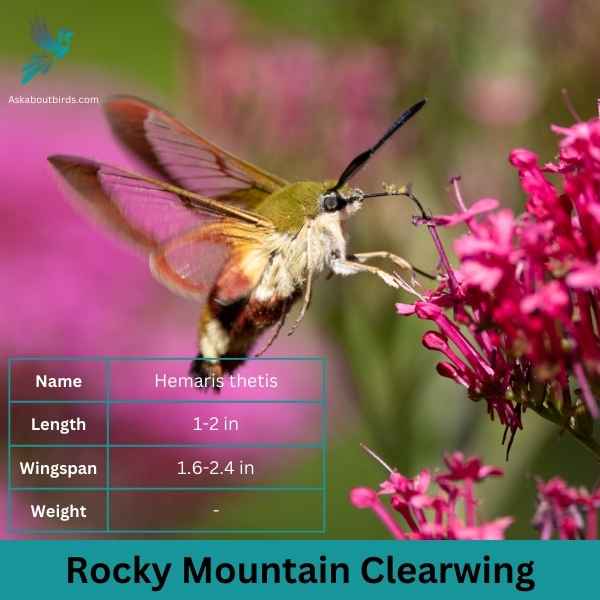
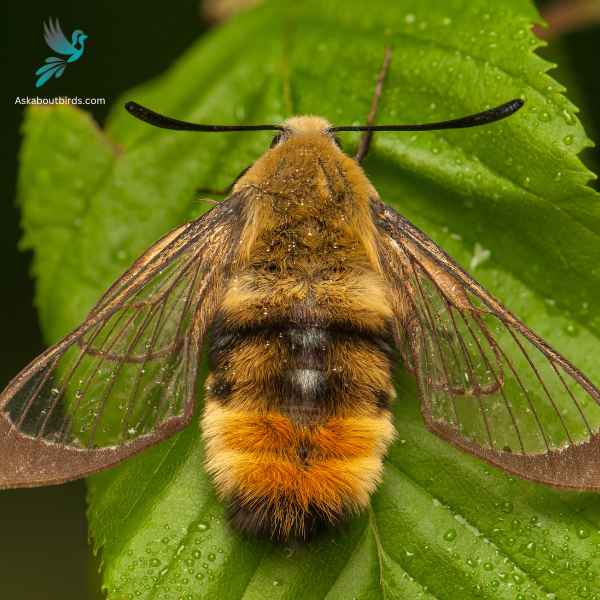
| Feature | Measurement |
|---|---|
| Scientific Name | Hemaris thetis |
| Length | 1-2 in |
| Wingspan | 1.6-2.4 in |
The Rocky Mountain Clearwing is a unique moth species found predominantly in the Rocky Mountain regions, notable for its transparent wings and hummingbird-like behavior.
Appearance: The Rocky Mountain Clearwing features a stout, furry body similar to most moths. However, what sets it apart is its translucent wings, which lack the typical scales found on other moths. This clearwing appearance combined with its fast flight often leads to it being mistaken for a hummingbird or a large bee at first glance.
Diet: Adult Rocky Mountain Clearwings primarily feed on nectar from various flowers, using their long proboscis to access it. This feeding behavior, coupled with their rapid wing movement, further accentuates their resemblance to hummingbirds. The caterpillars, on the other hand, feed on specific host plants found in their natural habitats.
Reproduction: Female Rocky Mountain Clearwings lay their eggs on or near their preferred host plants. Once the caterpillars emerge, they feed voraciously, eventually pupating in the soil or under leaf litter. After undergoing metamorphosis, the adult moths emerge to continue the cycle.
Similarities
- Like hummingbirds, they hover in front of flowers while feeding.
- Both have rapid wingbeats.
Differences
- Rocky Mountain Clearwings are moths, not birds.
- They do not have the iridescent feathers that hummingbirds possess.
Hummingbird Clearwing
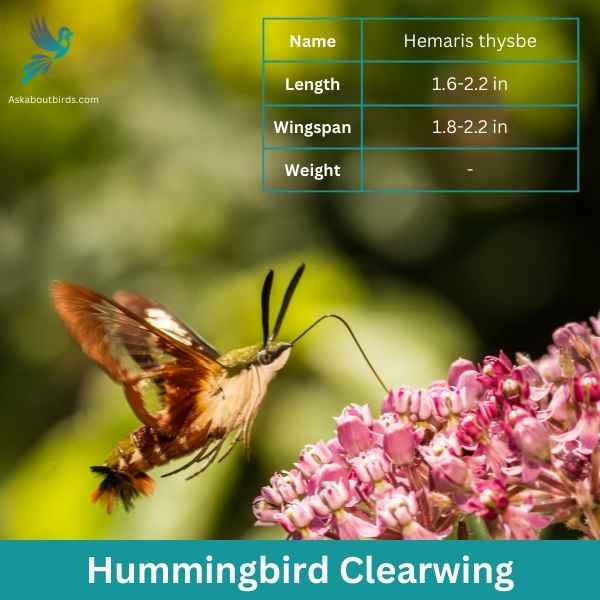
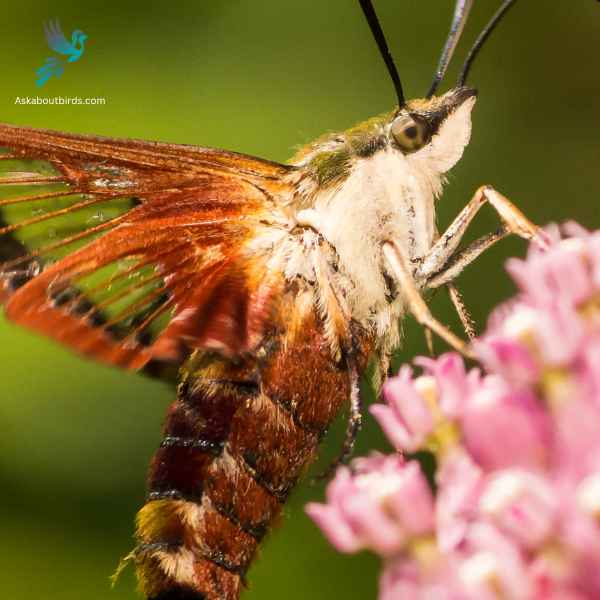
| Feature | Measurement |
|---|---|
| Scientific Name | Hemaris thetis |
| Length | 1.6-2.2 in |
| Wingspan | 1.8-2.2 in |
The Hummingbird Clearwing is a remarkable moth species found mainly in North America, drawing attention due to its striking resemblance to hummingbirds.
Appearance: The Hummingbird Clearwing sports translucent wings, allowing it to be easily distinguished from other moths. Its body is generally olive-green to golden-brown with a furry texture. With its rapid wing movement and hovering behavior, it can easily be mistaken for an actual hummingbird when seen from a distance.
Diet: Adult Hummingbird Clearwings primarily feed on nectar from various flowers, using their long proboscis to access the sweet liquid. Their preference for daytime feeding and their hummingbird-like flight patterns enhance the illusion of them being tiny birds rather than moths. Caterpillars of this species typically feed on the leaves of specific host plants.
Reproduction: Females lay their eggs on the underside of leaves of their host plants. After hatching, the caterpillars feed on these plants until they’re ready to pupate. They then form cocoons in the leaf litter or just below the soil surface. After undergoing metamorphosis, the adult moths emerge, ready to continue the life cycle.
Similarities
- Both hover in front of flowers to feed.
- Similar size to many hummingbirds.
Differences
- Hummingbird Clearwings are moths, not birds.
- They lack the iridescent feathers of hummingbirds.
White-lined Sphinx
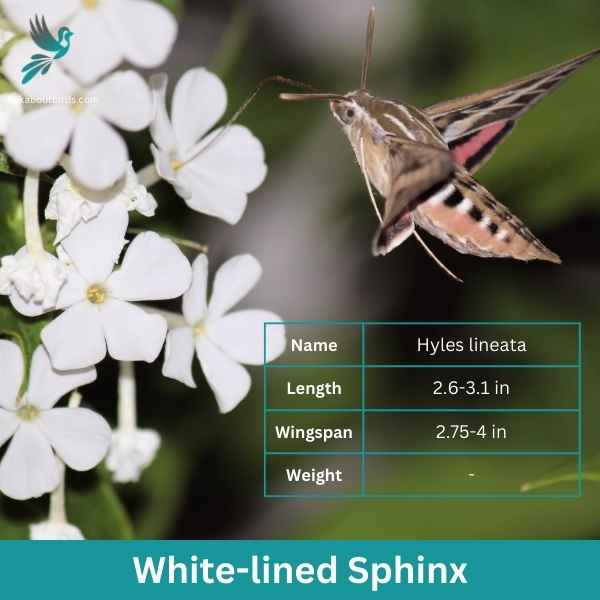
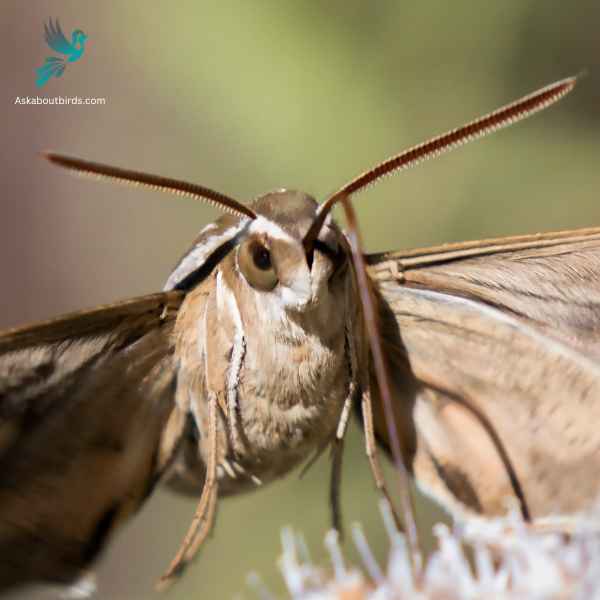
| Feature | Measurement |
|---|---|
| Scientific Name | Hemaris thetis |
| Length | 2.6-3.1 in |
| Wingspan | 2.75-4 in |
The White-lined Sphinx is an intriguing moth species commonly found throughout North America, recognized for its large size and distinct wing patterns.
Appearance: The White-lined Sphinx is notable for its broad wingspan and unique patterns. Its forewings are typically dark with white streaks and some pink highlights, while its hindwings showcase a vibrant pink or reddish hue in the center, bordered by black. The moth’s body is robust and typically brown or gray with white lines and sometimes pink bands.
Diet: Adult White-lined Sphinx moths predominantly feed on nectar from various flowers, hovering in front of blooms and using their long proboscis to drink. This behavior, combined with their swift flight, often draws comparisons to hummingbirds. The caterpillars, on the other hand, have a varied diet, feeding on the leaves of several different plants, including grapevines and primroses.
Reproduction: Females lay their eggs on the host plants’ leaves. After hatching, the caterpillars consume the foliage of these plants until they reach maturity. Once ready, they burrow into the ground to pupate. Following the metamorphic process, adult moths emerge to mate and start the life cycle anew.
Similarities
- Like hummingbirds, they hover in front of flowers while feeding.
- Both have rapid wing movements.
Differences
- White-lined Sphinx moths are insects, not birds.
- They do not possess the bright and varied colors of hummingbirds.
Types of Hummingbird species in US
The United States is home to several species of hummingbirds, especially in the western and southwestern regions. While some species are residents year-round, others migrate between the U.S. and Central or South America. Here’s a list of hummingbirds that can be found in the U.S.:
- Ruby-throated Hummingbird (Archilochus colubris)
- The only species regularly found east of the Mississippi.
- Black-chinned Hummingbird (Archilochus alexandri)
- Commonly found in the western U.S.
- Anna’s Hummingbird (Calypte anna)
- A resident of the western coastal U.S., particularly California.
- Costa’s Hummingbird (Calypte costae)
- Found mainly in the deserts of the southwest.
- Rufous Hummingbird (Selasphorus rufus)
- Known for its remarkable migration, it breeds in the Pacific Northwest and Alaska and winters in Mexico.
- Allen’s Hummingbird (Selasphorus sasin)
- Primarily found along the coast of California.
- Broad-tailed Hummingbird (Selasphorus platycercus)
- Found in the mountainous areas of the western U.S.
- Calliope Hummingbird (Selasphorus calliope)
- The smallest breeding bird in North America, found mainly in the western U.S.
- Broad-billed Hummingbird (Cynanthus latirostris)
- Primarily seen in southeastern Arizona and southwestern New Mexico.
- Violet-crowned Hummingbird (Amazilia violiceps)
- Found in parts of Arizona and New Mexico.
- Lucifer Hummingbird (Calothorax lucifer)
- Found in parts of West Texas, southern New Mexico, and southeastern Arizona.
- Magnificent Hummingbird (Eugenes fulgens)
- Seen in the mountains of Arizona and New Mexico.
- White-eared Hummingbird (Basilinna leucotis)
- Found in some parts of southeastern Arizona and southwestern New Mexico.
- Blue-throated Hummingbird (Lampornis clemenciae)
- Seen in the mountains of Arizona and New Mexico.
These are the primary species that can be found in the U.S., though on rare occasions, other species might stray across the border. The western U.S., especially areas like southeastern Arizona, is a hotspot for hummingbird diversity.
FAQS on Bird Species That Look Like Hummingbirds
How Many hummingbird species?
There are over 300 recognized species of hummingbirds, making them the second-largest bird family in the world. These remarkable birds are found primarily in the Americas, from Alaska to Tierra del Fuego, with the majority of species inhabiting Central and South America. The smallest is the bee hummingbird.
How fast do hummingbirds flap their wings?
Hummingbirds are renowned for their rapid wing beats. The average hummingbird flaps its wings between 50 to 80 times per second. This incredible speed allows them to hover in place, dart quickly from flower to flower, and perform agile aerial maneuvers. The exact rate can vary based on the species and specific activity, such as hovering versus forward flight. For instance, when hummingbirds are hovering, they tend to flap their wings at the higher end of this range to maintain their position in the air.
The Giant Hummingbird (Patagona gigas) is the largest hummingbird species, and its wingbeat frequency is notably slower compared to its smaller counterparts. The Giant Hummingbird flaps its wings approximately 10 to 15 times per second. This slower wingbeat rate is in stark contrast to the rapid flapping of smaller hummingbirds, but it’s a natural consequence of the Giant Hummingbird’s larger size and mass. Even with the slower wingbeat, they are agile flyers and are still capable of hovering like other hummingbirds.
Is there a bird that looks like a hummingbird?
Yes, there are several bird species (and even some insects) that might be mistaken for hummingbirds due to their size, behavior, or appearance. Here are a few examples:
- Sunbirds (Family: Nectariniidae): Native to Africa, Asia, and parts of Australia, sunbirds are nectar feeders like hummingbirds. They display iridescent plumage and can hover momentarily, but they usually perch when feeding. Their long, down-curved bills are adapted for extracting nectar from flowers.
- Honeyeaters (Family: Meliphagidae): Found primarily in Australia and New Guinea, many species of honeyeaters feed on nectar. They are varied in size and appearance, but some can resemble hummingbirds, especially in their feeding behavior.
- Flowerpeckers (Family: Dicaeidae): These tiny birds from Asia can be mistaken for hummingbirds because of their size and preference for nectar and small fruits. They often move swiftly between trees and shrubs.
- Sphinx Moths or Hawk Moths (Family: Sphingidae): While they are insects and not birds, sphinx moths can easily be mistaken for hummingbirds, especially in fleeting glances. They hover in front of flowers while extending a long proboscis to feed on nectar, mimicking the hovering behavior of hummingbirds. In North America, species like the Hummingbird Clearwing (Hemaris thysbe) often lead to misidentifications.
- Fairy-wrens (Family: Maluridae): Found in Australia, these small, brightly colored birds might be mistaken for hummingbirds due to their size and vibrant colors, but their behavior and feeding habits are quite different.
While these birds and moths may resemble hummingbirds to some extent, a closer observation will usually reveal distinguishing features. For instance, most of the birds listed above (except for the moths) have legs and toes that are more visible in flight than those of hummingbirds. Additionally, hummingbirds are unique to the Americas, so their presence in other continents would be highly unlikely.
What is the most common hummingbird in the US?
The most common hummingbird in the U.S. is the Ruby-throated Hummingbird (Archilochus colubris). It’s the only hummingbird species that breeds regularly in the eastern half of the United States and eastern Canada. During the breeding season, they can be found from southern Canada to the Gulf of Mexico.
While hummingbirds migrate and are renowned for their affinity for flower nectar, are there other small birds from the finch family that might be confused with the smallest hummingbird due to their size and diet?
Although the finch family contains various small birds, none of them exhibit the hovering flight behavior commonly associated with hummingbirds when feeding on flower nectar. The smallest hummingbird is distinctively tiny, making it unlikely to be confused with finches based solely on size. However, some finches do incorporate nectar into their diet, but their feeding methods and overall behavior are quite different from hummingbirds.




